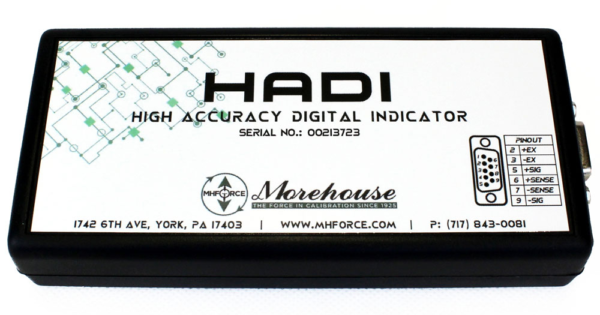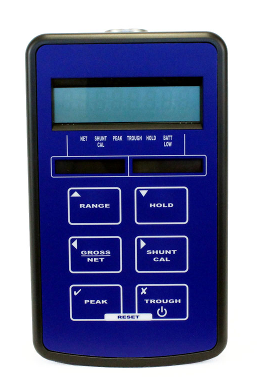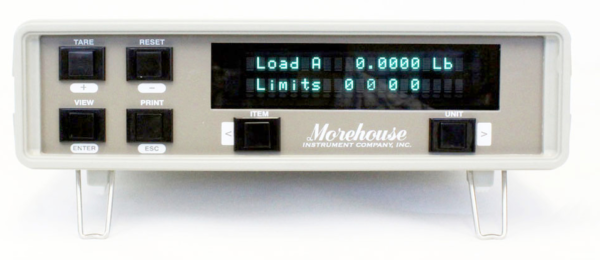Choosing the Right Load Cell Indicator
| Does the indicator have to be better than 0.005 %? Are you willing to use a computer to convert mV/V to Engineering Units? Do you require portability without a power adapter? Do you have more than two load cells? |
HADI |
|
| Do you require portability without a power adapter? Do you only have one load cell or two one-mode-only load cells? Are you okay with close-to-direct reading? Do you want portability with batteries? |
PSD |
|
| Does the indicator have to be better than 0.005 %? Do you have more than two load cells? Do you want to span multiple calibration points? Do you want to use Coefficients from the calibration report? |
4215-plus |
|
There are several other indicators on the market, and many will have different tradeoffs that need to be considered. The end determination should be based on a combination of the following:
Choose an indicator based on non-linearity and uncertainty specifications – Different indicators will have different specifications. What most users typically look for is the specification for non-linearity. The better this specification is, the less the indicator will contribute to the system uncertainty. Looking at the indicators offered by Morehouse, the clear winner is the HADI system in this category with a non-linearity of better than 0.002 % of full scale. The 4215 would be the second choice with better than 0.005 % and then the PSD with 0.005 % of Full Scale.
Some indicators on the market may specify accuracies in terms of the percentage of reading. Although these may include specifications such as 0.005 % of reading, they can cause negative impacts on the system's uncertainty. The problem is the resolution or number of digits may be such that the specification may not be maintained. In some other cases, the indicator might require adjustment at various span points to achieve non-linearity between span points that they are substituting an overall accuracy specification.
Generally, the purpose of multispanning the range in an indicator is to divide the sensor output range into smaller segments and reduce non-linearity errors as a result. Our general advice is to avoid this type of meter or call the manufacturer and ask them what is included in the accuracy specification. Ask them if it includes stability over time, repeatability, non-linearity, temperature characteristics, and consideration of the resolution. We often find the accuracy of the claims is questionable.
It is also noteworthy to mention that non-linearity errors in a load system can be drastically reduced by employing the right calibration and measurement process by pairing a highly stable indicator to the load cell, having the system calibrated to highly accurate standards such as Primary Deadweight Standards, and using ASTM E74 or ISO 376 calibration coefficients to convert load cell output values into force units. All of this system can be achieved by using HADI or 4215 indicators in conjunction with Morehouse calibration software included with the indicators.
Choose based on stability and drift – This characteristic is often more difficult to quantify on non-high-end multimeters. Some indicators will specify thermal drift and long-term stability of zero, and some will have actual stability per range. The meters that are often over $ 10,000 will fall into specifying drift at different intervals such as 90 days and one year. Most meters under $ 2500.00 are not going to specifically address 90 days or 1-year stability. Stability can be monitored and maintained by the use of a load cell simulator, or one can choose to live with the entire system drift of the load cell and meter combined. In this category, the $10,000 plus meters from Agilent, Keysight, and Fluke win, but these are not portable and are often overkill for general application force systems. We believe that Morehouse HADI with a Long-Term Stability of Zero at 0.0005 %/year at room temperature is the best non-$10,000 plus choice.
Choose based on resolution – If you are using the indicator as a field system, a stable resolution of greater than 50,000 counts over the output range of the load cell will allow for higher-order fits and is desirable for ASTM E74 calibrations as a higher-order fit will generally yield a Lower Limit Factor (LLF) and better Class AA and Class A loading ranges. If you are looking for a good meter to pair with your load cell as a reference standard to calibrate other load cells and are okay using mV/V readings, then the HADI is the best choice as it can display 4.00000 mV/V stable to within 0.00001 mV/V on a good load cell. The 4215 is a close second as it is typically stable to within 0.00002 mV/V.
Choose based on the number of span points- This assumes you require the actual display to read in engineering units and are not okay with 4.00001 mV/V representing 10,000.0 force units such as LBF or kN. If you want the indicator to read 10,000.0 when 10,000.00 is applied and do not want to use a computer relying only on the psychical display, then the 4215 is the winner with multiple span points. Another very good option is the Morehouse/Admet Gauge Buster with High Stability option. The meter comes standard with a 5-span point calibration and a 10-pt. Linearization is also available, but the downfall of any system that is set up for direct reading is it cannot be maintained. As the system drifts, so will the readings. So, 10,000.0 today may equate to 10,000.9 in a year. Therefore, we highly recommend having the output read in mV/V and converting it via software.
Choose based on environmental conditions - There are specifications such as Temperature effect on Zero and Temperature effect on Span. The winner in this category is the HADI with a Typical 1 ppm per degree Kelvin and a max of 2 ppm.
Choose based on four or six-wire sensing – There is a blog about the difference between 4-wire and 6-wire systems here. In general, cable resistance is a function of temperature and length. A 4-wire system will have additional error from temperature changes and from using different length cables. In fact, changing a cable in most cases will require calibration, while a 6-wire system will run sense lines separate from excitation and eliminate the effects due to these variations. 4215 and HADI are both 6-wire systems.
Choose based on required load cell output – Some meters cannot or will not handle load cell output above 2.5 mV/V which could create problems with 3 mV/V and 4 mV/V load cells. All Morehouse meters handle load cells with output up to 4.5 mV/V. The PSD, HADI, and 4215 are equal in this regard.
Choose based on ease of use – This is preference-based. Ease of use could be not having to use a computer or plug into a power supply. It could be not having to use load tables and having the computer grab readings by simply pushing the spacebar. If the end-user wants something simple that does not need a power cord, the PSD is the winner. If the end-user wants a portable system that can run on laptop power and can capture readings, the HADI is the winner.
Choose based on ruggedness – The HADI and PSD are both enclosed and are a bit more durable than 4215. The PSD would be the hardest to break physically and would be the best choice for a very rugged environment where a computer cannot go.
Choose based on the number of load cell channels required – If the end-user wants to use several load cells on the system, either the 4215 or HADI can be used. If the requirement is to set each of these channels up to multiple span points, the 4215 or the Morehouse/Admet Indicator would win.
Choose based on excitation voltage – some end users may have the requirement to change the excitation voltage or have a specific requirement for a 10V dc excitation to be applied to the sensor. In this scenario, 4215 is the only choice.
Choosing the Right Load Cell Indicator - Conclusion
Choosing the right indicator is a matter of your personal preferences. The HADI indicator comes in first place for several selection criteria, but these may not be the criteria that matter for your individual needs. Choose the indicator that meets your needs with the best non-linearity and stability specifications. If you need a rugged, battery-powered indicator with at least 50,000 counts of resolution, a PSD is a great choice. If you need a stable system and you can carry a laptop with you, then the HADI may make the most sense. Finally, if you need a system where you must have a live display, can use a computer, and need a 10V excitation source, then 4215 would be a great option.
If you enjoyed this article, check out our LinkedIn and YouTube channel for more helpful posts and videos.
Everything we do, we believe in changing how people think about force and torque calibration. Morehouse believes in thinking differently about force and torque calibration and equipment. We challenge the "just calibrate it" mentality by educating our customers on what matters and what causes significant errors, and focus on reducing them.
Morehouse makes our products simple to use and user-friendly. And we happen to make great force equipment and provide unparalleled calibration services.
Wanna do business with a company that focuses on what matters most? Email us at info@mhforce.com.





